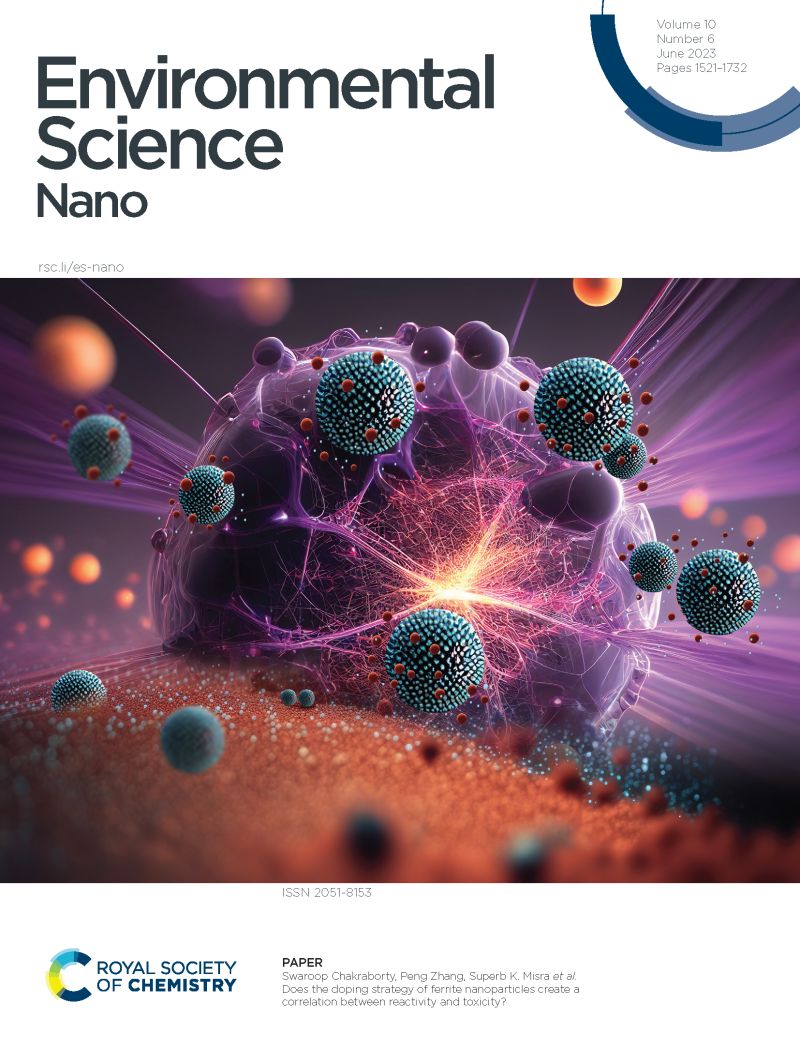Antibacterial Efficacy of Light-Activated Graphene Oxide Nanoparticles and Nanochitosan in Water
IF 5.8
2区 环境科学与生态学
Q1 CHEMISTRY, MULTIDISCIPLINARY
引用次数: 0
Abstract
Water quality is a crucial aspect of public health, and microbial contamination remains a significant challenge, necessitating the exploration of innovative water treatment methods. This study investigated the inactivation of Escherichia coli AW 1.7 in water driven by light-emitting diodes (LED) emitting UV-A (365 nm), near UV-visible (395 nm), and blue (455 nm) light in combination with graphene oxide (GO) nanoparticles (NP) and nanochitosan (NC). E. coli inoculum was added to NP solutions (0.2 and 0.3 % of GO and NC) and treated with the LED for 10 and 20 min. Results demonstrated that all GO treatments with different LED reduced E. coli populations below the limit of detection (LOD) (>5 log CFU/mL). In the case of NC (0.2 and 0.3%), UV-A was more effective on the photocatalytic inactivation with >5 log CFU/mL reduction in the E. coli population. The combination of NP, H2O2, and 365 nm LED also gave significant (p-value <0.05) E. coli reductions. Among individual LED treatments, UV-A was more effective in inactivating the E. coli. The higher oxidation-reduction potential (ORP), electrical conductivity, and lower pH contributed to the greater E. coli inactivation with GO and LED combination treatments. The Fourier-transform infrared spectroscopy showed partial photoreduction of oxygen-containing functional groups in GO, while the structure of NC remained relatively unchanged. The study suggests the photocatalytic antibacterial potential of GO and NC, highlighting their application in water treatment.光活化氧化石墨烯纳米颗粒和纳米壳聚糖在水中的抗菌效果
水质是公共卫生的一个重要方面,微生物污染仍然是一个重大挑战,需要探索创新的水处理方法。本研究研究了在发光二极管(LED)发出UV-A (365 nm)、近uv -可见光(395 nm)和蓝光(4555 nm)的情况下,氧化石墨烯(GO)纳米颗粒(NP)和纳米壳聚糖(NC)联合驱动下,水中大肠杆菌aw1.7的失活。将大肠杆菌接种物添加到NP溶液(含氧化石墨烯和NC的0.2%和0.3%)中,用LED处理10和20分钟。结果表明,不同LED的氧化石墨烯处理均使大肠杆菌数量低于检测限(LOD) (>5 log CFU/mL)。在NC(0.2和0.3%)的情况下,UV-A对大肠杆菌群体的光催化失活更有效,减少了>;5 log CFU/mL。NP、H2O2和365 nm LED的组合也能显著(p值<;0.05)减少大肠杆菌。在单独的LED处理中,UV-A在灭活大肠杆菌方面更有效。氧化石墨烯和LED组合处理后,较高的氧化还原电位(ORP)、电导率和较低的pH值有助于大肠杆菌的失活。傅里叶红外光谱显示氧化石墨烯中含氧官能团发生了部分光还原,而NC的结构相对保持不变。研究表明,氧化石墨烯和氧化石墨烯具有光催化抑菌的潜力,在水处理中的应用尤为突出。
本文章由计算机程序翻译,如有差异,请以英文原文为准。
求助全文
约1分钟内获得全文
求助全文
来源期刊

Environmental Science: Nano
CHEMISTRY, MULTIDISCIPLINARY-ENVIRONMENTAL SCIENCES
CiteScore
12.20
自引率
5.50%
发文量
290
审稿时长
2.1 months
期刊介绍:
Environmental Science: Nano serves as a comprehensive and high-impact peer-reviewed source of information on the design and demonstration of engineered nanomaterials for environment-based applications. It also covers the interactions between engineered, natural, and incidental nanomaterials with biological and environmental systems. This scope includes, but is not limited to, the following topic areas:
Novel nanomaterial-based applications for water, air, soil, food, and energy sustainability
Nanomaterial interactions with biological systems and nanotoxicology
Environmental fate, reactivity, and transformations of nanoscale materials
Nanoscale processes in the environment
Sustainable nanotechnology including rational nanomaterial design, life cycle assessment, risk/benefit analysis
 求助内容:
求助内容: 应助结果提醒方式:
应助结果提醒方式:


